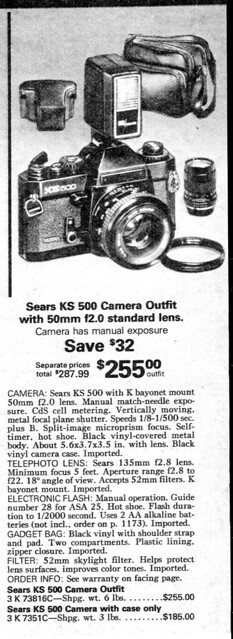Difference between revisions of "Sears KS 500"
m (price declined later) |
Hanskerensky (talk | contribs) (Category:K|KS 500 Sears) |
||
| (6 intermediate revisions by one other user not shown) | |||
| Line 7: | Line 7: | ||
|image_rights= nc | |image_rights= nc | ||
}} | }} | ||
| − | Immediately following on from the [[Sears KS 1000 | KS 1000]], US retailer [[Sears]] offered the '''KS 500''' in its 1979 Spring/Summer catalog<ref> A [https://christmas.musetechnical.com/ShowCatalogPage/1979-Sears-Spring-Summer-Catalog/0581 scan of page 581] shows it alongside the KS 1000 as well as a rebadged [[Mamiya]] SLR; from [https://christmas.musetechnical.com/ Musetechnical's "Christmas Catalogs & Holiday Wishbooks."]</ref> at a price of USD $239.50 (about $800 in 2021 dollars). This was the second [[K mount lenses | K-mount]] camera offered by Sears and once again is a rebadging of a [[Ricoh]] model—specifically the [[Ricoh KR-5 | KR-5 (no suffix)]] | + | Immediately following on from the [[Sears KS 1000 | KS 1000]], US retailer [[Sears]] offered the '''KS 500''' in its 1979 Spring/Summer catalog<ref> A [https://christmas.musetechnical.com/ShowCatalogPage/1979-Sears-Spring-Summer-Catalog/0581 scan of page 581] shows it alongside the KS 1000 as well as a rebadged [[Mamiya]] SLR [[Mamiya MSX 1000 | using their proprietary bayonet mount]]; from [https://christmas.musetechnical.com/ Musetechnical's "Christmas Catalogs & Holiday Wishbooks."]</ref> at a price of USD $239.50 (about $800 in 2021 dollars). This was the second [[K mount lenses | K-mount]] camera offered by Sears and once again is a rebadging of a [[Ricoh]] model—specifically their cost-reduction exercise the [[Ricoh KR-5 | KR-5 (no suffix)]]. |
| − | + | Quite a few features were sacrificed to get what was initially just around a 13% price savings versus the "1000." Available shutter speeds are limited to 1/8 to 1/500 second plus B (with flash sync at 1/60th), there is no depth-of-field preview, and no "ME" ([[Multiple exposure |multi-exposure]]) switch. Neither shutter speeds nor aperture are displayed in the viewfinder. (In place of the KS 1000's aperture "peepsight" on the front of the [[pentaprism]], there is a plain blanking plate.) | |
The film advance lever of the KS 500 must be pulled outward to unlock the shutter release and activate match-needle exposure meter readings, with power provided by two silver-oxide button cells (type 357 or SR44 are suitable). | The film advance lever of the KS 500 must be pulled outward to unlock the shutter release and activate match-needle exposure meter readings, with power provided by two silver-oxide button cells (type 357 or SR44 are suitable). | ||
| + | The KS 500 had a comparatively long run in Sears' lineup (into 1983) as their entry-level [[SLR]] option, with the camera's price dropping over time,<ref> It was [https://christmas.musetechnical.com/ShowCatalogPage/1980-Sears-Fall-Winter-Catalog/1312 below USD $150 by the Fall/Winter 1980 catalog], pg. 1312, and in [https://christmas.musetechnical.com/ShowCatalogPage/1983-Sears-Christmas-Book/0434 Christmas 1983], pg. 434; scans courtesy [https://christmas.musetechnical.com/ Musetechnical's "Christmas Catalogs & Holiday Wishbooks."]</ref> and based on surviving examples this seems to have helped sales. The [[Sears KSX-1000]] was a later camera continuing its tradition of a basic manual-exposure model; but by the mid 1980s, stripped-down autoexposure models like the [[Sears KS Super II | KS Super II]] would take its place as the retailer's lowest price bracket SLR. | ||
| Line 20: | Line 21: | ||
==Links== | ==Links== | ||
*An online [https://www.butkus.org/chinon/ricoh/kr-5/kr-5.pdf owner's manual] for the Ricoh KR-5, from Mike Butkus' [https://www.butkus.org/chinon/ OrphanCameras.com] | *An online [https://www.butkus.org/chinon/ricoh/kr-5/kr-5.pdf owner's manual] for the Ricoh KR-5, from Mike Butkus' [https://www.butkus.org/chinon/ OrphanCameras.com] | ||
| + | |||
| + | [[Category:Sears]] | ||
| + | [[Category:K mount]] | ||
| + | [[Category:Japanese 35mm SLR]] | ||
| + | [[Category:K|KS 500 Sears]] | ||
Latest revision as of 18:09, 31 May 2021

|
| KS 500 listed in the Spring/Summer 1980 Sears catalog scanned by Voxphoto (Image rights) |
Immediately following on from the KS 1000, US retailer Sears offered the KS 500 in its 1979 Spring/Summer catalog[1] at a price of USD $239.50 (about $800 in 2021 dollars). This was the second K-mount camera offered by Sears and once again is a rebadging of a Ricoh model—specifically their cost-reduction exercise the KR-5 (no suffix).
Quite a few features were sacrificed to get what was initially just around a 13% price savings versus the "1000." Available shutter speeds are limited to 1/8 to 1/500 second plus B (with flash sync at 1/60th), there is no depth-of-field preview, and no "ME" (multi-exposure) switch. Neither shutter speeds nor aperture are displayed in the viewfinder. (In place of the KS 1000's aperture "peepsight" on the front of the pentaprism, there is a plain blanking plate.)
The film advance lever of the KS 500 must be pulled outward to unlock the shutter release and activate match-needle exposure meter readings, with power provided by two silver-oxide button cells (type 357 or SR44 are suitable).
The KS 500 had a comparatively long run in Sears' lineup (into 1983) as their entry-level SLR option, with the camera's price dropping over time,[2] and based on surviving examples this seems to have helped sales. The Sears KSX-1000 was a later camera continuing its tradition of a basic manual-exposure model; but by the mid 1980s, stripped-down autoexposure models like the KS Super II would take its place as the retailer's lowest price bracket SLR.
Notes
- ↑ A scan of page 581 shows it alongside the KS 1000 as well as a rebadged Mamiya SLR using their proprietary bayonet mount; from Musetechnical's "Christmas Catalogs & Holiday Wishbooks."
- ↑ It was below USD $150 by the Fall/Winter 1980 catalog, pg. 1312, and in Christmas 1983, pg. 434; scans courtesy Musetechnical's "Christmas Catalogs & Holiday Wishbooks."
Links
- An online owner's manual for the Ricoh KR-5, from Mike Butkus' OrphanCameras.com